Fear and Loathing (of the Free Press) in Standing Rock.
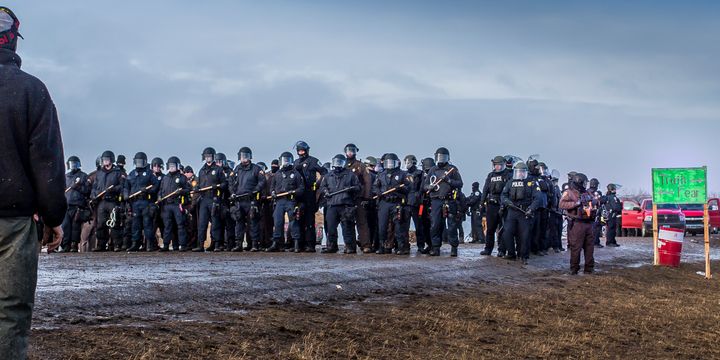
On February 22, 2017, various law enforcement agencies blocked access to the media staging area and threatened all who remained on the road, including journalists, with arrest.
Beneath the dusking sky in Standing Rock, North Dakota, on February 21, 2017, approximately 50 journalists gathered on a hillside overlooking the Oceti Sakowin Camp, where for months thousands of people from all over the world had converged to fight against the construction of the 3.8 billion dollar Dakota Access Pipeline.
Some of the journalists were trying to protect themselves and their camera equipment from the spitting rain that had started up once again. Others simply resigned themselves to the elements. Most were covered in mud.

Inside Oceti Sakowin camp on the day the eviction order went into effect, February 22, 2017.
Everyone knew that in less than 24 hours the camp was scheduled to be raided by a militarized force, which consisted of local, state and federal police departments, Homeland Security, the National Guard, the Bureau of Fish and Wildlife, the Bureau of Alcohol, Tobacco and Firearms, the Bureau of Indian Affairs and, reportedly, the NSA, among other law enforcement agencies.
For days, few corporate media outlets had been seen near the camp making it all the more important for the independent and citizen journalists to report and document and witness what was an eventuality: the violent destruction of the camp.
In a mere 10 months, Standing Rock came to symbolize so much more than a pipeline fight. As a place and as a concept, Standing Rock had manifest into the nexus of various social justice struggles, and revealed the interconnectedness of Indigenous Rights, Climate Justice, Women’s Rights, Black Lives Matter, LGBTQ rights, the militarization of the police, income inequality, too big to fail finance, and criminalizing dissent, to name a few.
Throughout the struggle at Standing Rock journalists were regularly suppressed, targeted, arrested and charged with crimes; the integrity of a free press and the First Amendment is, certainly, roiling within the hub of Standing Rock’s social justice maelstrom.
On the hillside that evening, there was a grim reality in covering the imminent raid and most everyone standing there wet, cold and muddy, knew what it was: in the eyes of the State, no one who remained in camp would be treated as, let alone considered to be, “a real journalist."
Not the freelance photographers filing for The New York Times, Huffington Post or NPR. Not the journalist from Vice. Not the journalist from The Intercept. Not the journalist from Buzzfeed. Not the journalist from Indigenous Rising Media. Not the journalist from Fusion. Not the journalist from Mic. Not the journalist from Digital Smoke Signals. Not the journalists from independent papers, on-line magazines or foreign news outlets. Not freelance journalists. Not citizen journalists. Not from Ruptly and SIPA, USA (with whom I was reporting), among others.
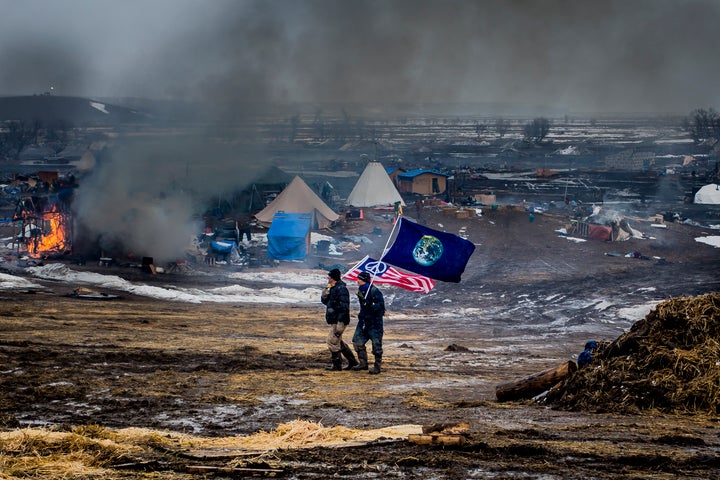
Approximately 100 water protectors remained inside the camp after the eviction deadline passed.
Governor Doug Burgum, along with his confederacy of government and corporate bullies, wanted to control the narrative and suppressing journalists, seemingly, was a priority. On the surface, their modus operandi may appear clunky and larded with intentional ineptitude, but it was an effective method to their unconstitutional madness.
To be considered a “real journalist” it was required to register with the North Dakota Governor's Department of Emergency Services, where they would decide who would receive credentials.
Many of the journalists I spoke with that night (and later the next day) did, in fact, have letters of assignment from their editors and had also attempted to phone and email, Rob Keller, the public information officer for the Morton County Sheriff's Department, who was handling the “so-called” credentialing process.
In what was passed off as a "clerical error," the telephone number provided to many of the independent journalists was incorrect. Journalists called for days. The email addresses provided were also wrong, apparently, as no journalist I spoke with ever received a response.
On the morning of the eviction, however, the correct number was leaked by a member of the Army Corps of Engineers, but too few on the ground knew about it. And guess what? Even if a journalist was able to scramble and obtain a Governor-approved credential (i.e. being added to a list), it didn't matter.
Why? Because the suppression of the press in Standing Rock was more egregious and far-reaching than simply ignoring, rejecting and criminalizing independent journalists.
Some of the journalists from the corporate outlets – who had Rob Keller's correct telephone number, apparently – were on the “credentialed list” but had restrictions foisted upon them once they signed their agreement (see below).
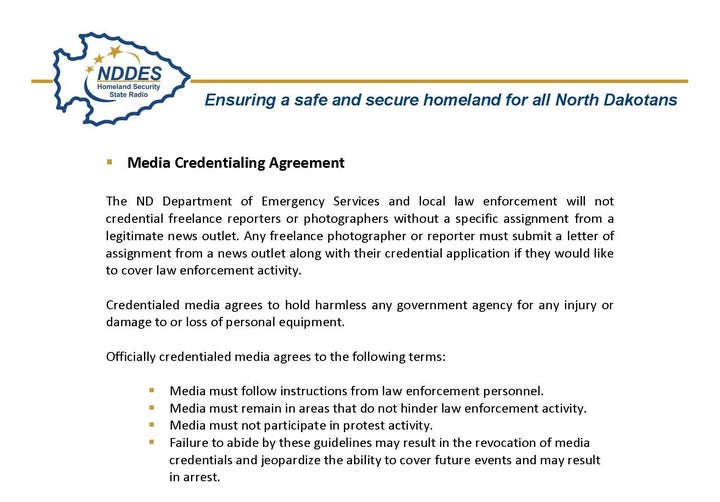
To be considered a working member of the press at Standing Rock, all journalists needed to signed the State's Media Credentialing Agreement.
This broadly written agreement meant that access to report and film was restricted to a police-approved designated media area. The gist of these rules: If you do not comply with the Governor's journalistic guidelines, you would be subject to arrest.
Freelance photojournalist Angus Mordant, who was filing for NPR during the week of the eviction period, had covered Standing Rock on-and-off since September 2016. In those six months, Mordant corresponded exhaustively with officials from the State of North Dakota, requesting a clear credentialing process, which, as Mordant would repeatedly tell the officials, “…would help identify members of the press to law enforcement.”
In one exchange Mordant wrote:
“I have covered wild fires, severe storms, and several mass protests and credentialed press have always been allowed to roam freely provided they leave immediately after the last people who decline to vacate have been removed/left/arrested.”
“Corralling or arresting press really doesn't help [journalists] tell the story and never results in positive press. Allowing us to tell the story accurately, provided we leave once the story is over, benefits all parties.”
On the day of the eviction, about a hundred yards away from the Oceti Sakowin entrance, on Highway 1806, the police set up their media staging area. This is where approved “credentialed media” were allowed to report.
“The media staging area was a joke,” a reporter who wished to remain anonymous told me, “You couldn’t see anything that was going on in the camp and I believe that was entirely [the police’s] intention.”
In a phone interview with Public Information Officer, Lt. Tom Iverson of the North Dakota Highway Patrol, who was on the ground during the scheduled eviction and helped facilitate with mainstream news outlets that were wrangled away from the camp and away from the actual story.
“We had tons of national media there… A host of media that obeyed and abided by [the] regulations. CNN, Fox, MSNBC, “ Iverson said.
After the 2 pm deadline had passed and people did not evacuate, various standoffs began with water protectors and journalists. According to LT. Iverson, the news outlets that were in media staging area began requesting access to the standoffs, wanting to leave the media pen, approach the scene and report.
“We gave the media the option to participate in a press pool where select media representatives were escorted to [the standoffs] and had five or ten minutes to film,” Iverson said.
![“We gave the media the option to participate in a press pool where select media representatives were escorted to [the standoffs] and had five or ten minutes to film.” — Lt. Tom Iverson, Public Information Officer of the North Dakota Highway Patrol](https://img.huffingtonpost.com/asset/58c4060b1e0000150077f314.jpg?ops=crop_0_0_2268_1512%2Cscalefit_720_noupscale)
“We gave the media the option to participate in a press pool where select media representatives were escorted to [the standoffs] and had five or ten minutes to film.” — Lt. Tom Iverson, Public Information Officer of the North Dakota Highway Patrol
Ed Higgins, Chief Correspondent for the independent outlet ActivateNow, is one of the journalists who submitted his media credential authorization form but never received confirmation.
"The whole process," Higgins told me in a phone interview, "was unprofessional and inappropriate. Mainstream Media was kept behind the police line, segregated from the real story. This allowed for a manufactured cultured narrative, which is not representative of the whole story."
Nick Cote, a freelance photojournalist who was filing for the New York Times, remained inside the main camp a few hours after the 2 pm deadline had passed but, when he attempted to re-enter the media staging area, was threatened with arrest.
According to Cote:
“I realized pretty quickly that it was a mistake to try to go through the police line, but I got lucky. I should've known not to trust them when they said it was OK to park there! If I didn't go back for it when I did though, I'm not sure when I would've seen my car again.”
If a press credential means you must stand away from the story and kowtow to a Governor’s constitutionally questionable edicts, is this really a free press? Or are you functioning as a mouthpiece for the very entity who is determining what part of the story you can cover?
By the time the actual eviction occurred, which was the morning of February 23, 2017, of the 50 or so independent journalists who had gathered the night before, only a handful remained inside the camp.
Without independent sources like the media collective Unicorn Riot, Myron Dewey at Digital Smoke Signals, Andrew Kimmell at BuzzFeed, Tim Schwartz of Inspire Bank Exits, Johnny Dangers, and others, the eviction of Oceti Sakowin would remain theoretical to an even larger swath of the population, if not utterly unknown.
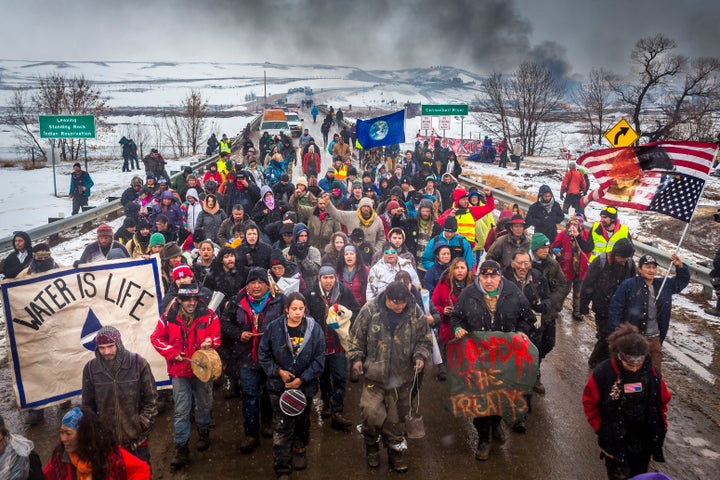
An hour prior to the deadline, a ceremonial exit of Oceti Sakowin. In December, some estimates were well over 10,000 people who were inside the camp.
But these independent journalists showed us images from the raid that looked no different from a military operation in, say, Iraq. They reported to the world the desecration of sacred sites. They livestreamed to tens of thousands across the globe snipers aiming at unarmed people.
They documented multiple arrests of independent journalists, including the brutal arrest on February 22, of livestreamer Eric Poemz, which, according to Poemz, resulted in a broken pelvis. And, also, photojournalist Tracie Williams, who was one of the few to find out that she was on the Governor-sanctioned press list on the morning of the eviction, hoping it would give her some sort of protection while reporting. Tracie would be arrested covering the eviction, while she was photographing the arrests of two water protectors praying near the Sacred Fire, and is now fighting the criminal charges.
“The police were targeting us,” Andrew Kimmel of BuzzFeed told me, “And where was the mainstream media? Where are they now? No one is defending us or reporting on these [first amendment] abuses.”
The aforementioned Angus Mordant told me in an email exchange that,
“Morton County and the other North Dakota authorities absolutely violated the constitutional freedom of the press. It is my understanding that in the same August-February period, North Dakota arrested more journalists than Syria. It was a militarized zone where the constitution seemingly doesn't apply.”
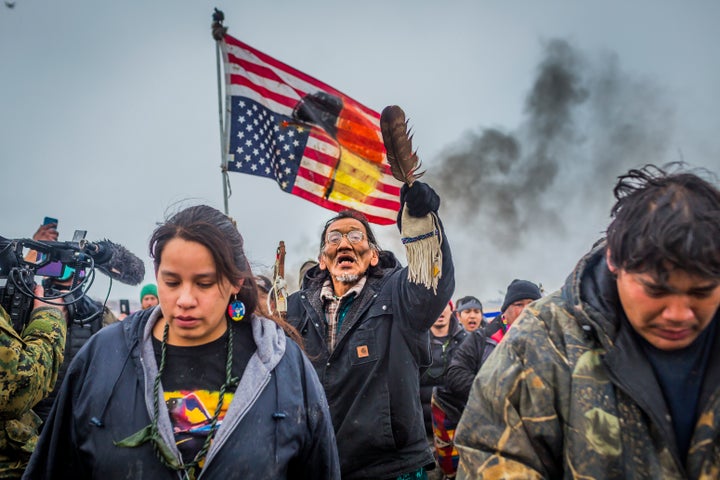
The New York Times has recently launched a powerful "Truth is..." campaign, running commercials during the Oscars, putting up billboards in strategic cities, blasting memes on social media feeds, and running ads in their own paper.”
Well, The Truth is, New York Times, there are journalists who chose not to report from the media staging area and are now facing criminal charges. That, too, needs to be defended.
The Truth is, NBC, on the scheduled day of the eviction, you contacted independent journalist Ed Higgins, who had been reporting from Standing Rock for four months, and poached his Livestream yet never offered him compensation. And in case you don't know, while Ed was reporting he was arrested inside the camp. Will you represent him in court? Will you be financially responsible for his defense and the potential fines?
The Truth is, ABC, there are still active lawsuits that could stop the Dakota Access Pipeline, namely “Jumping Eagle v. Trump,” filed by Tangerine Bolen and her largely volunteer group at RevolutionTruth.org. Standing Rock is Treaty Land. Treaties, as per article VI of the Constitution, are the supreme law of the land. The invasion of this land breaks the 1851 Treaty of Fort Laramie. It is not government property.
The Truth is, CBS, Standing Rock-style camps are popping up across the country -- in Oregon, Florida, Iowa, Louisiana, Pennsylvania, New Jersey -- attempting to stop other pipelines.
The Truth is, Fox, there was a reason why structures were set ablaze inside the camp; some were considered sacred and ceremonially burned so that they wouldn’t be desecrated by the awaiting militarized force.
The Truth is, CNN, your correspondent Sara Sidner reported from the media staging area after the evacuation deadline had passed. On live TV she described a message that had been written upon an unplugged TV screen, which had been placed in front of the camp entrance. The message read, The revolution will not be televised. As if offended by this, before Sidner threw it back to Jake Tapper, she said in a self-congratulatory retort, “I beg to differ.”
Is there a more fitting illustration of how the mainstream media undercuts its own credibility? (View clip at 2:40)
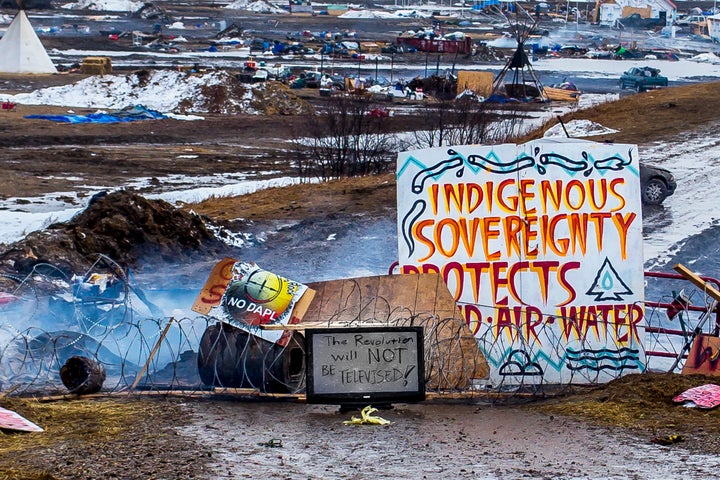
The entrance of Oceti Sakowin after the deadline to evacuate passed.
From the beginning weeks at Standing Rock, the impression was that authorities were trying to silence journalists from reporting on the fight to stop the pipeline.
There’s a strange and cynical poetry to how independent journalists struggled to first report on the significance of Standing Rock, effectively making it profitable for the corporate media to actually show up and shoehorn the story into their 24-hour news cycle, only to be abandoned by the very organizations who, because of Trump, are now effusively howling on the importance of the free press and the First Amendment.
Yes, for a democratic society to function, freedom of the press is essential. But for freedom of the press to function, it means that the standard of newsworthiness should not depend on if a story generates corporate revenue.
Corporations will exploit everything until there is no profit left to glean. This is true of the fossil fuel industry. This is true of the corporate media.
Is this why a great majority of the corporate media retreated from covering the last days at Standing Rock? They had nothing left to exploit? It’s possible. Or, perhaps, this particular stand for freedom of the press wasn’t worth the aggravation.
If Standing Rock as a concept, and everything it represents, continues to spread across the globe – as many are working toward – it will be the independent news sources reporting on it first, the freelance photojournalists burrowing in to capture frames of the truth, until the story becomes financially viable for the corporate media to report on it.
And that is, unfortunately, the truth.
